North Slavey Alphabet Chart
This document contains North Slavey sounds, words in which they are found, and pictoral representations of those words. For example, “a,” “sah,” and a picture of a bear or “ts,” “tsá,” and a picture of a beaver.
Access this Resource:
North Slavey Alphabet Chart. Northwest Territories Department of Education, Culture, and Communications, 1990.
The Dene Standardization Project
The standardization project began in 1987, with a mandate to make recommendations on orthography standardization. Five linguists and one fluent/literate speaker from each language group made up the planning committee, in addition to invited elders and other members for working committees for each language group.
- Dene alphabets have a one-to-one sound to symbol correspondence. The same sound is always represented by the same symbol.
- There are differences in use and pronunciations between communities, people, and age groups.
- Therefore, recommendations say to keep the system as phonetic as possible (writing exactly what one hears) while trying to strive towards regional standardization. Consensus is that the speech of elders should be chosen as the standard for writing, because “the speech of elders retains greater morphological information than the contracted or shortened forms which are found in the speech of younger speakers.”
Arguments for standardization:
- Preserving the speech of elders.
- Easier to teach and learn literacy.
- Curriculum materials can be disseminated across a region.
- Uniform Dene orthographies will “facilitate the production of printed materials” across Dene languages in private and public sectors.
Abstract:
The 1986 report by the Canadian Task Force on Aboriginal Languages, which recommended that the writing systems used for the northern Dene languages be standardized within 10 years, resulted in the 1987 Dene Standardization Project. The mandate for the project was to make recommendations on orthography standardization as the first step in the process of encouraging widespread native language literacy, the publication of native language materials, and ultimately the preservation of the Dene languages in a technological era that places high demands for literacy and depends on the print media for the retention and transmission of information. This paper reports on the Dene languages and writing systems in the Northwest Territories, the Dene alphabetic system, and types of and rationale for standardization. Recommendations deal with five broad orthographic issues: alternate pronunciations, alphabet symbols, use of symbols, word divisions, and punctuation. The concluding paragraphs note that the Dene Standardization Project is a model for other language groups undertaking orthographic standardization. (LB)
Access this Resource:
Read the full paper online: http://jan.ucc.nau.edu/~jar/NALI3.html
Or, download the PDF from ERIC: https://eric.ed.gov/?id=ED354768
Biscaye, Elizabeth and Mary Pepper. “The Dene Standardization Project.” In Effective Language Education Practices and Native Language Survival edited by Jon Reyhner, 23-29. Oklahoma: Native American Language Issues, 1990.
A Grammar of Slave
Part of de Gruyter’s Grammar series, this text provides a detailed and comprehensive grammatical description of the Dene language categorized as Slave or Slavey at the time of writing. Keren Rice conducted fieldwork in Fort Good Hope and elsewhere in the Sahtú beginning in 1973.
About the series:
The series builds an extensive collection of high quality descriptions of languages around the world. Each volume offers a comprehensive grammatical description of a single language together with fully analyzed sample texts and, if appropriate, a word list and other relevant information which is available on the language in question. There are no restrictions as to language family or area, and although special attention is paid to hitherto undescribed languages, new and valuable treatments of better known languages are also included. No theoretical model is imposed on the authors; the only criterion is a high standard of scientific quality.
Read an open access review of Rice's Grammar by James Kari of the Alaska Native Languages Centre: http://www.jstor.org/stable/30028003
Access this Resource:
Rice, Keren. A Grammar of Slave. Berlin: Mouton de Gruyter, 1989.
Read the Google Books Preview:
Introduction to Dene Studies: Teacher's Guide
This document is a preface to a Grade 10 Dene Studies course, to be piloted in 1988/89. Dene studies curriculum was produced by the Department of Education of the Northwest Territories and the Dene Nation beginning in 1986-1987. The 1987-1988 Dene Studies project team included Georgina Blondin, Ernie Camsell, Cheryl Fennell, Cynthia Flood, Bruce Fraser, Patricia Keays,and Patricia Robison. The document outlines Grade 10 Dene Studies design, structure, content, and approach; forexample, learning objectives around the significance of the Dene drum. It also provides a reading list and outlines several activities.
An illustrative section of the text: Principles on which Dene Studies is based reads, “1. Culture is learned. We learn fully about culture in communities, with people, not in a classroom. The instructional setting limits the aspects of culture that can be explored, particularly when the culture under study is land and group/community based. Dene Studies concentrates on those aspects of culture that can be taught in a classroom, but recognizes that classroom study alone will not lead to full knowledge and understanding of Dene culture.” (4)
Access this Resource:
Dene Studies curriculum documents are held in the NWT Archives. See item no. N-2007-014: 1-1.
Dene Studies Project Team. Introduction to Dene Studies, Teacher’s Guide. Yellowknife: Northwest Territories Department of Education and the Dene Nation, 1988.
North Slave Terminology List
This is a scan of looseleaf notes, some typed, some hand-written, going over Dene language translations for terms related to government, world politics, emotions, the environment, and health. This document is interesting for the historical context shaping each definition. Some examples include:
Royal commission on aboriginal affairs
Dǫ dezǫ naáwo k’e eghálagı́de
People working on aboriginal issue
Political parties
Gogha ehkw’e k’é eghálats’éda
We follow what we believe
Communist
Ndéts’ǫ́ k’aáwo yatı k’é zǫ hǫɂǫ
They take only the government’s word
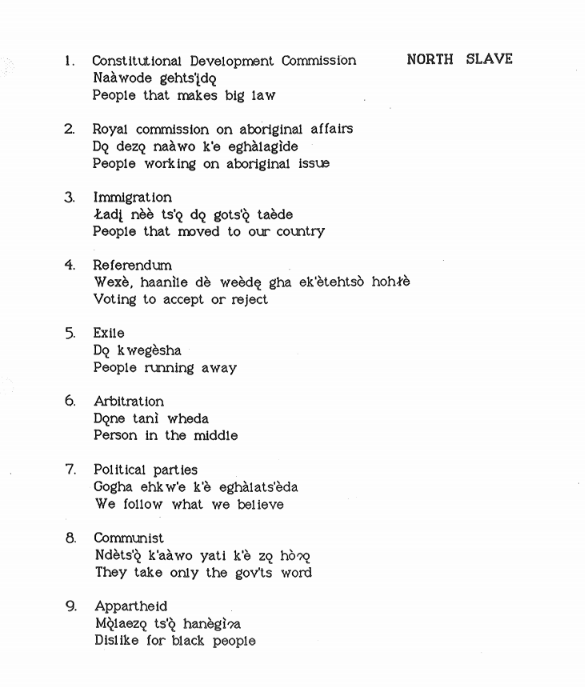
Access this Resource:
Available from the Ɂehdzo Got’ı̨nę Gots’ę́ Nákedı archives. Contact This email address is being protected from spambots. You need JavaScript enabled to view it. for access and see the Release and User Agreement form on the database home page.
North Slave Terminology List. Translated by Lucy Ann Yakelaya. Yellowknife: Government of the Northwest Territories Language Bureau, 1987.
Dene Ke Tatso Yéhdá Negerı́chú
This is a unilingual story with hand-drawn illustrations and North Slavey text. There is an English guide at the end (p.28) which explains that a group of dene people lived on an island happily, along with Tatsǫ́ (the Raven). Tatsǫ́ was a prankster, and was so disruptive that the dene took away his beak. Tatsǫ́ tries to trick them by making mud people to distract the community so he can steal his beak back. He takes it from a blind elder, who mistakes him for a child. He flies away with his beak returned to him. This document has a stamp on the last page that reads “Interpreter/Translator Program.” The first two lines read:
Yahnı̨́ı̨ ts’ę́ dene ło du k’e gonezǫ́ nágedé. Du k’e gonezǫ́ t’á dene surı́ gogha gonezǫ. Eyu du k’e dene nágedé goghá Tatsǫ́ k’ola nágwe redı. Tatsǫ́ dene keg ok’áláwe zǫ. Tatsǫ́ goɂǫ́ dene ke gok’áláwe, hé goɂǫ́ gode zǫ t’á dene ke gogha nezǫ́ le.
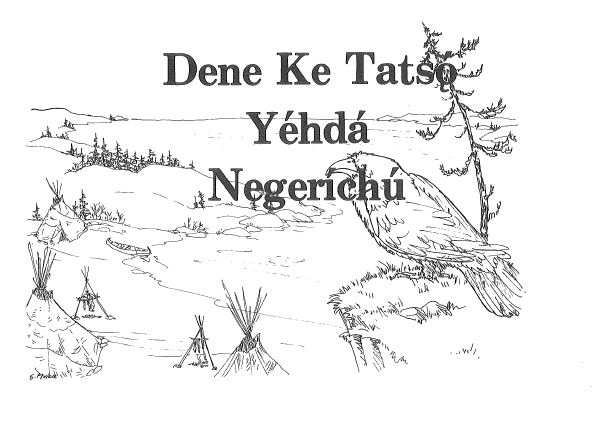
Access this Resource:
Available from the Ɂehdzo Got’ı̨nę Gots’ę́ Nákedı archives. Contact This email address is being protected from spambots. You need JavaScript enabled to view it. for access and see the Release and User Agreement form on the database home page.
Tetso, John, Elsie Vital, Gina Bayha, Gloria Lafferty Miller [Illustrator], Jane Modeste and Fibbie Tatti [eds.]. Dene Ke Tatso Yéhdá Negerı́chú. Délı̨nę: Fort Franklin Band Council, 1986.
Asiı̨́ı̨ Bemǫne Gúlı́ Héoratı’ı̨ [Adapted from "Shapes," a curricular text published by Usborne/Hayes]
This is a unilingual storybook that teaches North Slavey terminology using shapes, silhouettes, and pictures. It appears to be adapted from a basic curricular text, “Shapes,” for Dene language learning.
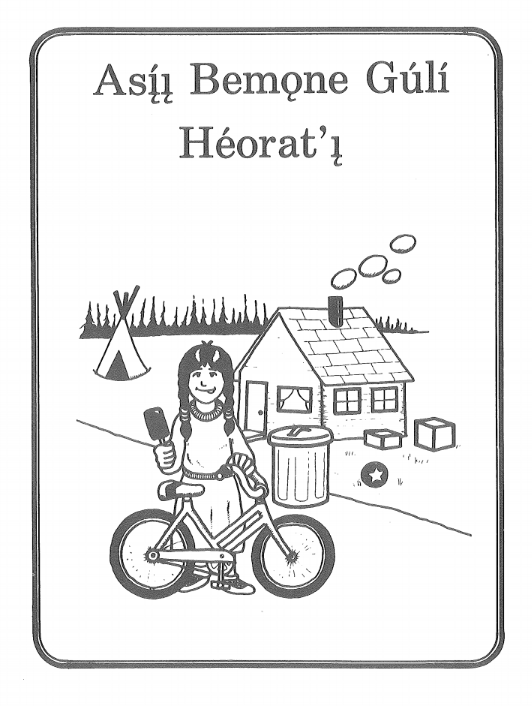
Access this Resource:
Available from the Ɂehdzo Got’ı̨nę Gots’ę́ Nákedı archives. Contact This email address is being protected from spambots. You need JavaScript enabled to view it. for access and see the Release and User Agreement form on the database home page.
Tatti, Fibbie, and Darin Ouellette. Asiı̨́ı̨ Bemǫne Gúlı́ Héoratı’ı̨. Adapted from Shapes, published by Usborne/Hayes. Yellowknife: Department of Education of the Northwest Territories, 1985.
Ɂehtsée Gah
This is a unilingual story with hand-drawn illustrations and Dene text, about an elder telling his granddaughter stories about rabbit, and teaching her lessons on the land.
Ɂı̨hbé ekúu kare gonezǫ t’á ts’ǫ́dane ke kare nágogeye. T’ere łée Gahzhoó héredı sı̨́ı etı̨́whęnę t’á ɂehke ke k’énategehde zǫ.
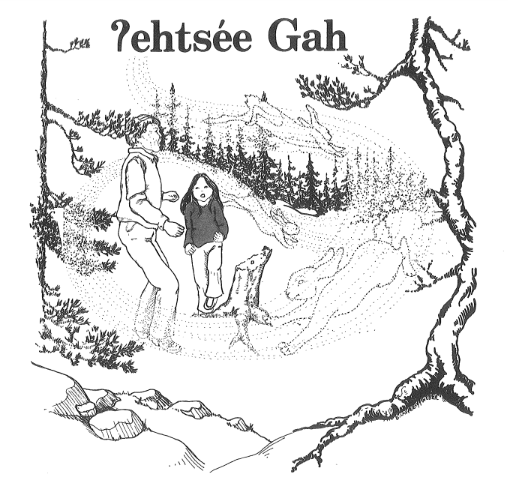
Access this Resource:
Available from the Ɂehdzo Got’ı̨nę Gots’ę́ Nákedı archives. Contact This email address is being protected from spambots. You need JavaScript enabled to view it. for access and see the Release and User Agreement form on the database home page.
Lafferty, Gloria, Mitsuko Oishi, Ronald Cleary, and Christine Cleary. Ɂehtsée Gah. Northwest Territories Department of Education. School Program Services, 1984.
Tatsǫ́ Ts’éku Hedenı̨́htł’é
This is a unilingual story with hand-drawn illustrations and Dene text. A community of animals is living peacefully until Raven, Tatsǫ́, plays a trick of some kind, is caught, and is forced to fly off by the rest of the group. The first section reads:
Tatsǫ́ Ts’éku Hedenı̨́ht’é
Yahnı̨́ı̨ ts’ę́ tı̨ch’ádı́ı sı̨́ı̨ dnee hı̨lé redı. Ekúu sı̨́ı̨ tı̨́ch’ádı́ı ke ası̨́ hóoyı̨́ı̨ gha, Tatsǫ́ gehɁa zǫ redı. Łánu dene ke nádé ghá Tatsǫ́ ts’u k’e danéhtła gháré, surı́ nǫhbále náaweɂa tah gogháeda.
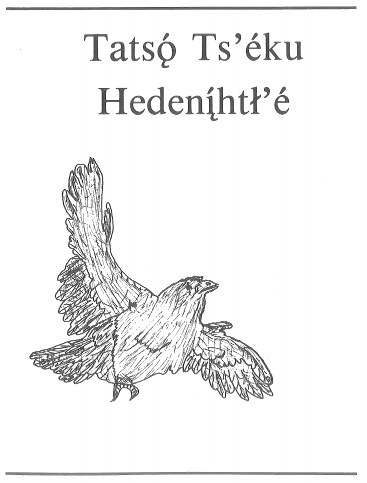
Access this Resource:
Available from the Ɂehdzo Got’ı̨nę Gots’ę́ Nákedı archives. Contact This email address is being protected from spambots. You need JavaScript enabled to view it. for access and see the Release and User Agreement form on the database home page.
Modeste, Jane, John Tetso, and Fibbie Tatti. Tatsǫ́ Ts’éku Hedenı̨́htł’é. Yellowknife: Program Services Division, Department of Education, Government of the Northwest Territories, 1984.
Koyére: Reader II Teacher Guide
This text is a teacher’s guide and lesson plan to go along with a Dene Reader. It is written primarily in English, with North Slavey provided in places where a teacher should ask a question of students in the Dene language, for example.
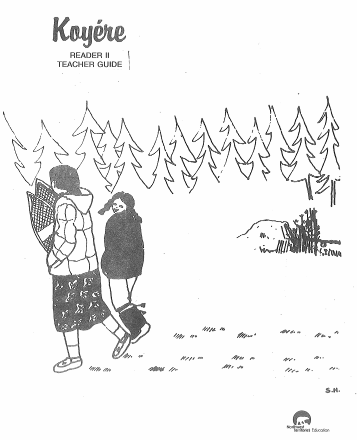
Access this Resource:
Available from the Ɂehdzo Got’ı̨nę Gots’ę́ Nákedı archives. Contact This email address is being protected from spambots. You need JavaScript enabled to view it. for access and see the Release and User Agreement form on the database home page.
Tatti, Fibbie, Mitsuko Oishi, and Doreen Cleary. Koyére: Reader II Teacher Guide. Northwest Territories Department of Education. Programs Services Division, 1984.




 Phone: 867-374-4040
Phone: 867-374-4040 Email:
Email: